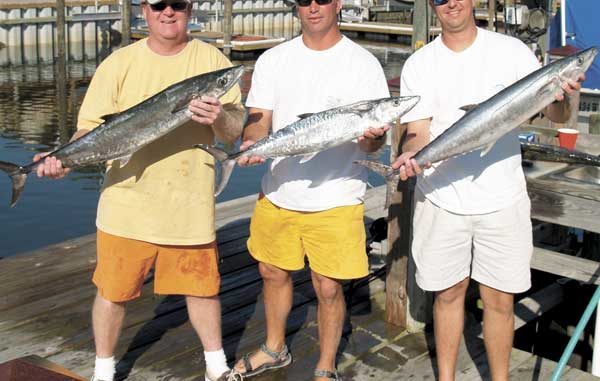
The headline on this column could be hyping the latest lure developed by a team of fish-researchers, but the truth is that mercury contamination of fish eaten by unwitting anglers is the real silent killer.
Preaching a “gloom and doom” philosophy is not the point, rather, it is to raise awareness among concerned sportsmen.
Mercury occurs naturally in the environment; however, industrial plants transform and release this natural mercury into a form of methyl-mercury, which can then be captured by rainfall and transferred to bodies of water. Fish absorb mercury from the water, but it can “stack-up” over time when larger predator fish consume quantities of smaller, contaminated fish.
Believe it or not, only one 8-ounce serving per month is suggested when eating larger-sized bluefish, flounder, Spanish mackerel, king mackerel, speckled trout and even blue crabs. Striped bass are also on the 8-ounce serving restriction list compiled by state agencies.
Fishermen should be especially concerned about consuming too much catfish, bass, bowfin or chain pickerel from an area referred to as “the mercury triangle” at the confluence of the Great and Little Pee Dee Rivers and continuing on downstream.
On the Lynches River, the state advises against eating ANY mudfish or channel catfish. Along the entire Edisto River down to Willtown Bluff, the S.C. Department of Health lists bowfin, largemouth bass, channel catfish, chain pickerel and flathead catfish on its DO NOT EAT list. Further Edisto River recommendations are that only one meal per week is allowable for black crappie, bluegill and bedbreast sunfish. Only one meal per month is recommended for blue catfish.
To view a map with all the DHEC Fish Advisories, go to this website: http://www.scdhec.gov/environment/water/fish/map.htm.
The SCDHEC and S.C. Department of Natural Resources have published a Fish Smart-Eat Smart brochure that talks about the health benefits of eating fish. As you may know, fish flesh is a great source of omega-3 fatty acids, oils, protein, vitamins and minerals. But if an adult unknowingly consumes too much fish that is tainted with mercury, he or she may experience loss of motor coordination, impaired speech, impaired hearing and mental disturbances. Risks to pregnant mothers and newborn children are much, much more severe than risks to adults.
Power plants that burn fossil fuels to create energy release the mercury that occurs naturally in coal into the air in the form of methyl-mercury. Power plants that burn coal contribute to some areas of mercury-in-fish pollution, while steel mills that smelt old automobiles containing mercury switches are another source of mercury emissions.
One of South Carolina’s state-owned utilities is proposing a coal-fired power plant at the confluence of the Lynches, Little Pee Dee and Great Pee Dee Rivers. In early December, the U.S. Department of the Interior recommended halting the approval of this new plant until a study could be completed on the harmful effects of mercury emissions, ranging from the plant all the way to the Cape Romain National Wildlife Refuge on the coast. Did you know that the Cape Romain NWR, which lies 60 miles southeast of the proposed plant, carries a “Class 1” designation under the U.S Clean Air Act, and is thus required to seek unparalleled air-quality protection?
Fisherman across the entire coastal area of South Carolina need to become more aware of the legacy of mercury pollution we may leave for future generations if we don’t curb our appetite for fossil fuels and embrace the incoming tide of renewable energy sources.
Furthermore, if you know someone who is eating a daily diet of fish from a contaminated area, you may want to approach them about the possible health complications. Older folks may not live long enough to notice the cumulative effects of built-up mercury, but younger folks with plenty of years ahead need to be forward-thinking on the matter of consumption of fish from contaminated areas.
Clearly, I still advocate eating plenty of fish, and going fishing remains one of life’s simple pursuits and pleasures. The SCDHEC website reminds fish-consumers that any fish purchased in a market or a restaurant is under mercury guidelines for consumer protection set by the U.S. Food and Drug Administration (FDA) and the U.S. Environmental Protection Agency (EPA).
The Post and Courier newspaper in Charleston has recently conducted random testing of individuals who ate fish from contaminated sites in the Pee Dee region. The shocking results discovered were that nearly half of those tested had mercury levels above the government’s safety margin. Mercury in fish does not alter the taste or appearance of the flesh, making the cornerstones of this issue:
* angler-education; and
* knowledge of DHEC fish advisories.
Returning to the saltwater fall-out, did you know that we are advised not to eat any meat from a king mackerel longer than 39 inches — otherwise known as a “smoker” king, while one meal per week is allowed for king mackerel between 33 and 39 inches?
Once again, the larger, older fish have spent more time in the water absorbing mercury and consuming mercury-tainted baitfish or smaller gamefish.
The alarming advisory on king mackerel consumption hits home with avid fishermen, because large kings provide the best fighting and are highly sought-after in organized tournament fishing.
Let’s hope that somehow the oceans will be able to cleanse our big kings over time — as well as other large fish — so we can consume the fish that we honor with our whole-hearted pursuit.
Ben Gregg, executive director of the South Carolina Wildlife Federation, said, “Scientists say the amount of mercury now being spewed into the air is three times what is was 200 years ago.”
That indicates that we have no baseline data or precedent which to study regarding mercury pollution, and all fishermen need to consider their options:
* sit back with a wait-and-see attitude until the next shocking statistic washes downstream, or:
* be prepared to speak up and take action to protect our public waters.



Be the first to comment